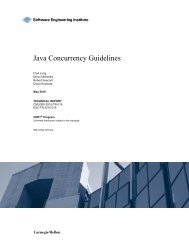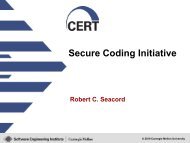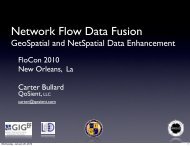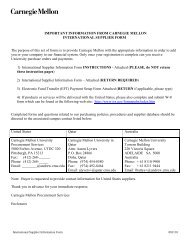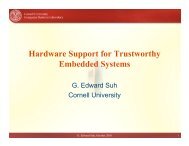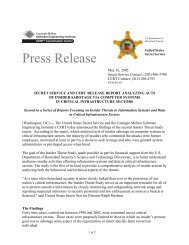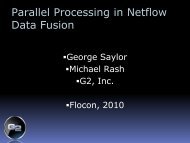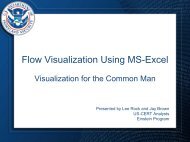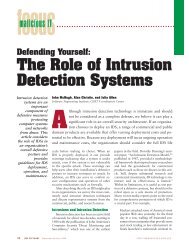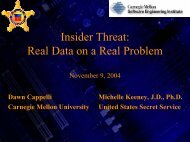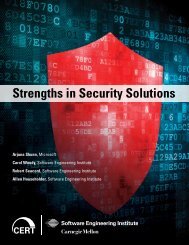CERT Resilience Management Model, Version 1.0
CERT Resilience Management Model, Version 1.0
CERT Resilience Management Model, Version 1.0
- No tags were found...
You also want an ePaper? Increase the reach of your titles
YUMPU automatically turns print PDFs into web optimized ePapers that Google loves.
Communications (COMM)—to institute procedures and guidelines for communications thatwill support the organization’s objective to preserve customer confidence even in times ofstressSimilarly, the organization described in Section 6.1.1 as having suffered financial losses due to asecurity incident might choose the following process areas as its model scope to facilitateimprovements to its incident management process and to implement more effective monitoringcapabilities:Incident <strong>Management</strong> and Control (IMC)—to ensure that appropriate practices areinstitutionalized to support incident responseMonitoring (MON)—to consistently instrument and monitor its operational environment sothat potential threats can be identified earlyBoth example organizations might choose additional process areas in later phases of animprovement effort or might identify additional needs resulting from implementing improvementsin these initial process areas.There are no firm rules about the minimum or maximum number of process areas that should beselected to include in the model scope. Care should be taken to select as many process areas asneeded to achieve the objectives, but few enough so that progress can be demonstrated in areasonable time frame for the sponsor and key stakeholders. If the objectives require a largenumber of process areas, then a time-phased approach should be considered.Targeted Improvement RoadmapsTargeted improvement roadmap (TIR) is a term that is used to designate a specific collection of<strong>CERT</strong>-RMM process areas that serve a particular improvement objective. An organization coulddeclare a TIR to represent its unique objectives for managing operational resilience, or might usea TIR that was designed by another organization or group. Industry groups might establish TIRsto represent their specific operational resilience concerns or to address an industry initiative ornew regulatory mandate. Also, an organization could establish TIRs for specific tiers of suppliersor external dependencies, and use the TIRs to support the evaluation, selection, and monitoring ofthose entities. Appendix B contains several example TIRs.In some cases, it may be appropriate to establish a finer-grained model scope than can be set bychoosing entire process areas. <strong>CERT</strong>-RMM provides for several fine-grained scoping options thatcan be used in such cases, as described below.Practice-Level ScopePractice-level scope enables the model scope to be limited to selected specific and genericpractices within a process area. This option does not have to be applied to all process areas whenestablishing the model scope, but may be appropriate for one or more process areas to addressspecific improvement needs or concerns. This scoping option may be useful in the early phases ofan improvement effort, in response to very narrow improvement objectives, or to be consistentwith the span of influence of the improvement sponsor.For example, suppose that an organization’s improvement objective is focused narrowly oninformation technology disaster recovery activities. From the Knowledge and Information69 | CMU/SEI-2010-TR-012



